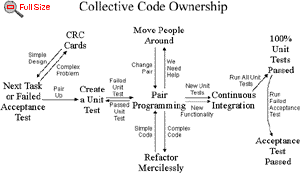 Use Class, Responsibilities,
and Collaboration (CRC) Cards to design the system as a team. The biggest value of CRC cards is to allow people
to break away from the procedural mode of thought and more fully appreciate object technology. CRC Cards allow
entire project teams to contribute to the design. The more people who can help design
the system the greater the number of good ideas incorporated. Use Class, Responsibilities,
and Collaboration (CRC) Cards to design the system as a team. The biggest value of CRC cards is to allow people
to break away from the procedural mode of thought and more fully appreciate object technology. CRC Cards allow
entire project teams to contribute to the design. The more people who can help design
the system the greater the number of good ideas incorporated.
 Individual CRC Cards are
used to represent objects. The class of the object can be written at the top of the card, responsibilities listed
down the left side, collaborating classes are listed to the right of each responsibility. We say "can be written"
because once a CRC session is in full swing participants usually only need a few cards with the class name and
virtually no cards written out in full. A short example is shown as part of
the coffee maker problem. Individual CRC Cards are
used to represent objects. The class of the object can be written at the top of the card, responsibilities listed
down the left side, collaborating classes are listed to the right of each responsibility. We say "can be written"
because once a CRC session is in full swing participants usually only need a few cards with the class name and
virtually no cards written out in full. A short example is shown as part of
the coffee maker problem.
 A CRC session proceeds with
someone simulating the system by talking about which objects send messages to other objects. By stepping through
the process weaknesses and problems are easily uncovered. Design alternatives can be explored quickly by simulating
the design being proposed. A CRC session proceeds with
someone simulating the system by talking about which objects send messages to other objects. By stepping through
the process weaknesses and problems are easily uncovered. Design alternatives can be explored quickly by simulating
the design being proposed.
 If you find too many people
speaking and moving cards at once then simply limit the number If you find too many people
speaking and moving cards at once then simply limit the number |

of people standing and moving cards to two. When one person sits down another may stand up. This works for sessions
that get out of hand, which often happens as teams become rowdy when a tough problem is finally solved.
 One of the biggest criticisms
of CRC Cards is the lack of written design. This is usually not needed as CRC Cards make the design seem obvious.
Should a more permanent record be required, one card for each class can be written out in full and retained as
documentation. A design, once envisioned as if it were already built and running, stays with a person for some
time. One of the biggest criticisms
of CRC Cards is the lack of written design. This is usually not needed as CRC Cards make the design seem obvious.
Should a more permanent record be required, one card for each class can be written out in full and retained as
documentation. A design, once envisioned as if it were already built and running, stays with a person for some
time. 
  |